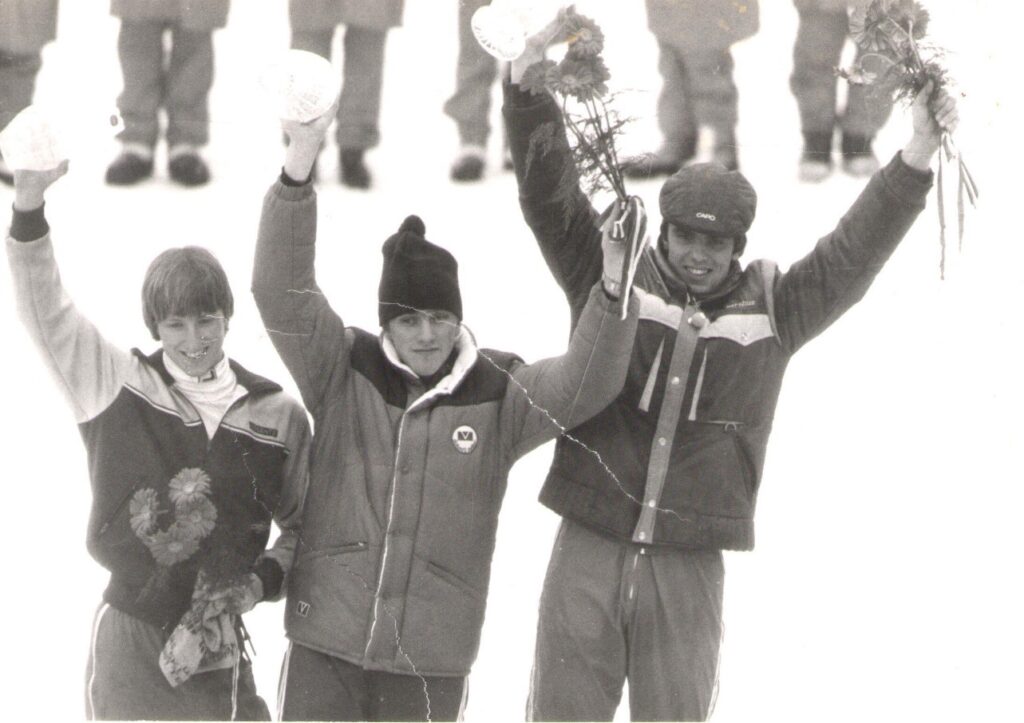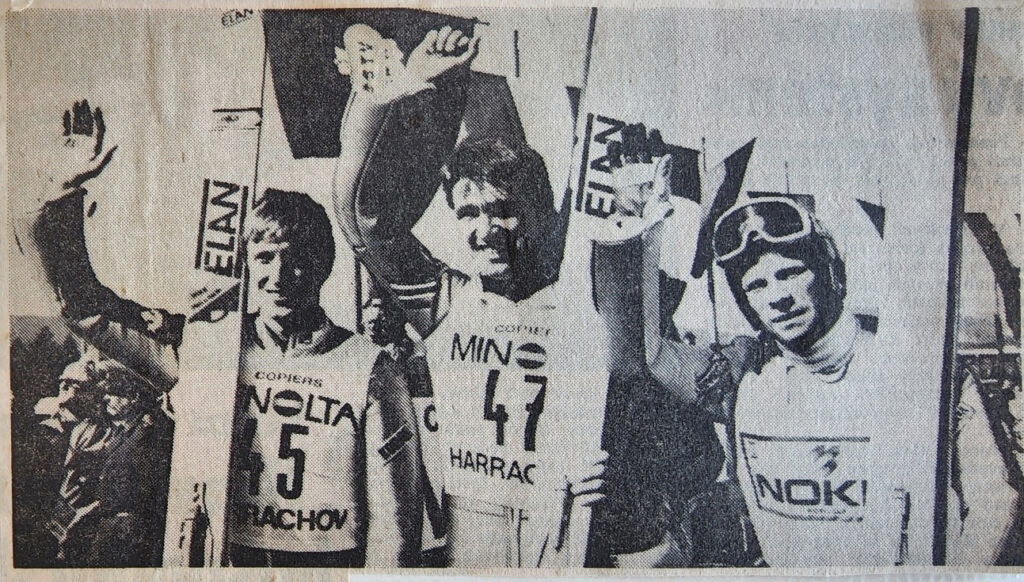Mike Holland
Ford Sayre Ski Club (NH)
Norwich, VT
mikeholland@preservationlandgroup.com
CURATOR’S NOTE: TRIGGER WARNING! This story contains descriptions of a couple of falls and Mike wanted me to share that Jan Boklov’s (SWE) V-style innovation since the mid 80’s was not only more aerodynamic but also significantly improved the stability in flight. The improved aerodynamics also allowed a lower the flight path and reduced the inrun speeds compared to the old style with skis parallel. It should also be noted neither athlete suffered any long term effects from their falls- both continued jumping for many more years after the events described below. While I have your attention, please be sure to click through the links that Mike embedded in his story- great content.
SCARED STRAIGHT
Harrachov, Czechoslovakia’s K120 launched me over the knoll as my skis moved in front of my right shoulder – my preferred flight position. On this particular jump, however, my tips continued moving to the right past my shoulder until I was completely sideways in the air. Swimming and flapping to 100 meters, I landed hard on my left hip and shoulder. A few cartwheels later, I stopped in the transition but could not breathe. When I looked up, there adjacent to the K120 was Harrachov’s enormous ski flying hill. My next jump is supposed to be up there, on the first day of the 1983 World Ski Flying Championships.
Back at the hotel, I entered coach Greg Windsperger’s room, “Greg, I don’t think I should jump tomorrow. If I twist and land on my side on that hill it will surely be end.” Greg showed me the video of my takeoff but he had erased the flight so I couldn’t see. He explained, “This was a one-time mistake. You’ve never done this before. If this was a pattern, I would likely advise you to sit this one out. But, it isn’t a pattern. You simply weren’t symmetrical on this one jump. You can do this.” Reluctantly, I agreed. Needless to say, I didn’t sleep much that night. The next morning, we worked on technique, focusing on jumping squarely from the takeoff. This was my first year with the U.S. Ski Team and I had only experienced ski flying once before in Vikersund, Norway earlier that winter (see Dennis McGrane’s account of that event).
The weather was terrible the next day for official training. 100,000 spectators lined the landing hill and outrun in the rain. It was so foggy that at times that the takeoff wasn’t visible from the top of the inrun. Horst Bulau of Canada (photo) was in the start as I jogged in place and stretched, waiting for my turn. Horst was ranked 2nd in the overall world cup standings at the time. I was thinking, here is the jumper to watch to give me confidence. At about 35 feet above the ground, Horst flipped and disappeared over the knoll. ARE YOU KIDDING ME? I thought. Shortly after, we heard the eerie call of the Czech ambulance’s siren “Beeee Dooo, Beeee Dooo, Beeee Dooo”. Horst was being rushed to the ER.
Ahead of me, and next in the gate, was Wolfgang Stiert from Germany. Ewald Roscher, Wolfgang’s coach, yelled through the fog, “Wolfgang, don’t jump!” Wolfgang removed his skis, clapped them together and with a smile said, “Goodbye boys”, as he safely walked from the start. Gulp, I slid into the start thinking, Surely Greg will give me the same good news. Through the fog, I saw Greg far below on the coaches stand holding up his arm. Five seconds later, he dropped his arm, giving me the go-ahead to jump.
OMG, I pulled out of the start and quickly reached a speed I had never experienced thinking the right technique is the safest technique, the right technique is the safest technique.
As I approached the bottom of the landing hill, I let go of the end of the flight, sacrificing a few meters to ensure a safe landing. I touched down at 177 meters, 3 meters short of the world record. That night in the hotel I encountered Pavel Ploc from the Czech team. He had just watched my first jump on video and said, “Mike, you are crazy, you could have had the world record but you let up at the end.” “I wasn’t ready for it. I was just trying to be safe!” I explained.
Forty years later, I called Greg to ask how he could have let me jump. “Weren’t you worried?”, I asked. Greg explained. “Yes, but, you were so good at focusing on technique that I knew you would be OK.”
After the competition, I reflected on my first practice jump and felt foolish for having given up a world record. It was discouraging to let such an opportunity slip away. I vowed that if I ever had the chance again, I wouldn’t waste it. Thus began two years of imagery, several times every day, preparing to break the world record, should the opportunity arise.
Two years later, at the next World Ski Flying Championships in Planica, Yugoslavia I decided NOT to watch anyone before my first official training jump. I knew I was ready, I had already broken the world record 500 times in my head. But, as the jumper before me approached the takeoff, I couldn’t resist and looked down the inrun. At about 30 feet above the ground, the jumper flipped and disappeared over the knoll. ARE YOU KIDDING ME? It was on this first training jump that I set the world record.
This is my 13th winter coaching in the Ford Sayre Ski Jumping program in Hanover, NH where Jeff Hastings first recruited me. Every winter, several of our young jumpers progress from our 20m to our 32m jump – a transition that always makes me nervous as a coach. Before one of my athletes climbs the stairs of the 32m inrun for the first time I’m careful to always explain, “The right technique is the safest technique, the right technique is the safest technique.”

Photo: Likely Landis Arnold or Nils Stolzlechner with Mike’s camera

“My last time ski flying was back in Harrachov at the 1989 World Cup. While nobody flipped in front of me, I was equally scared, and hyper focused on jumping square and symmetrical from the takeoff.”
Photo (above) and caption (below) from the Los Angeles Times, March 20,1989.
Ole-Gunnar Fidjestoel won the next-to-last event in the World Ski Jumping Cup season. The reigning world ski flying champion soared 178 meters in the first round, the farthest distance of the day, missing his hill record by only five meters. Fidjestoel’s series of 178, 159 and 129 meters gave him a total of 356.10 points, with American Mike Holland second with jumps of 176, 158 and 153 for 355 points. Jan Boklöv, father of the V-style, was third.
